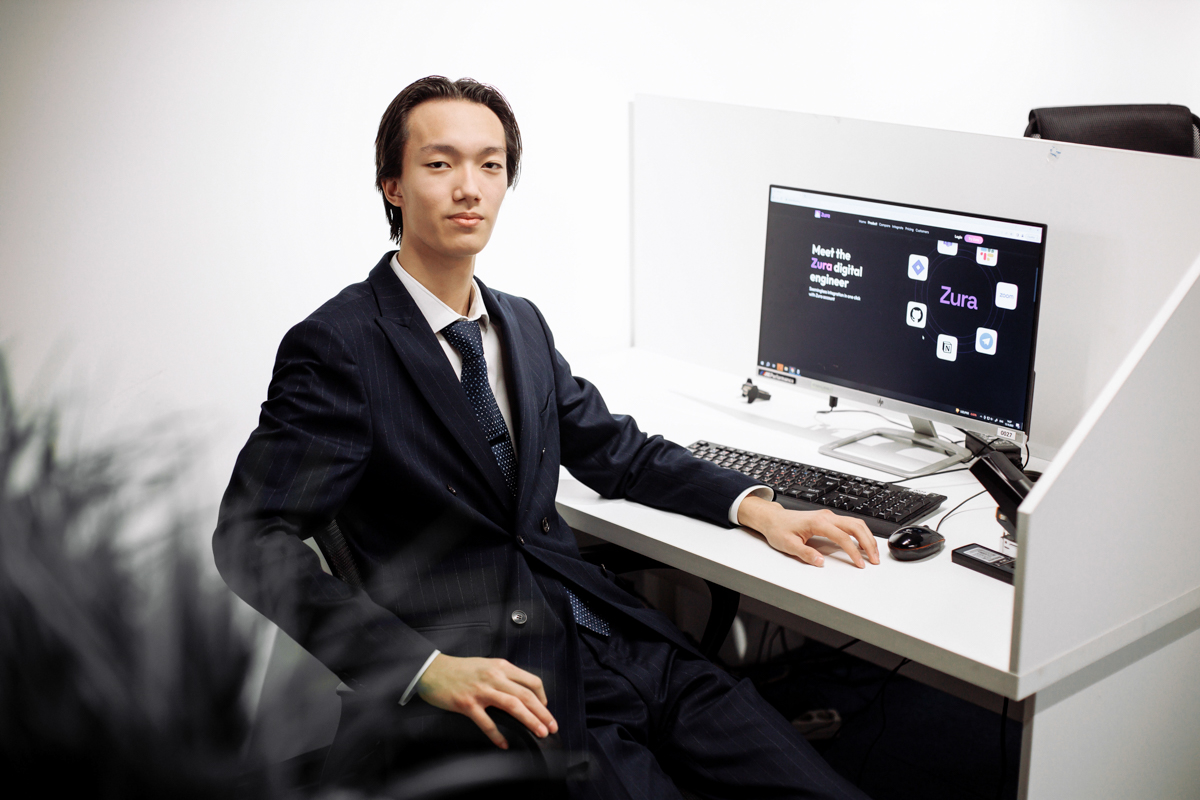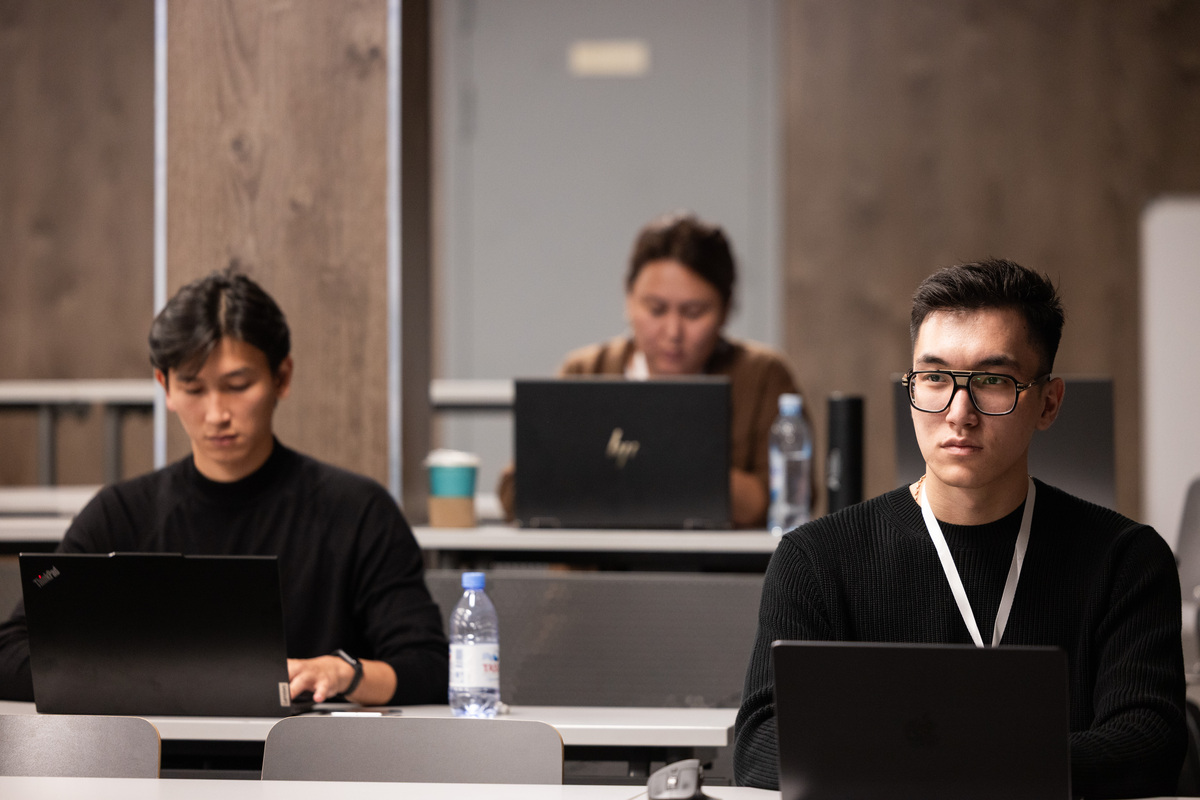Kazakhstani Startup Introduces AI Bot Redefining IT Company Developer Roles

At the age of 18, Arsen Kylyshbek is the owner of the AI startup WhoockAI, which proposes to IT companies the substitution of junior developers with AI. These digital specialists are more cost-effective, do not consume coffee, and produce code on par with their human counterparts.
During the interview for the collaborative initiative with Astana Hub titled "100 Startup Stories of Kazakhstan", Arsen discussed his faith in AI and highlighted the detrimental impact of ageism when presenting ideas to investors.
We initially began with the website builder, but later executed a pivot
— This year, I completed my studies at the Republican Physics and Mathematics School in Astana and chose not to pursue further education. Instead, I opted to concentrate on my startup and the field in which I am already proficient.
I've been involved in entrepreneurship since the age of 14. My inaugural project was an agency specializing in website development. We used WordPress as our platform, enabling us to tackle complex projects such as e-commerce websites and tender websites, among others. Following that, I ventured into an educational startup that unfortunately didn't thrive due to a multitude of silly errors. Nevertheless, I don't harbor any significant regrets because this endeavor granted me valuable knowledge, experience, and a network of contacts.
Today, I collaborate on Whoock with Ilyas Makirov, my childhood friend since our very first year of primary school. He has held positions as a backend developer in various companies and currently serves as a Middle+ backend developer at Halyk Bank.

— What is the core concept of Whoock?
— Initially, our concept revolved around crafting a website builder reliant on text-based requests. Prior to this, I delved into web development and experimented with various no-code solutions, but none of them seemed suitable to me. They often required frequent plugin additions through PHP and manual database handling. I've been learning programming since my fourth year of school, so I could manage these aspects. However, for individuals without a technical background, even using platforms like Tilda could lead to confusion.
Although existing services have significantly simplified website development, a fundamental grasp of concepts such as frontend, backend, databases, and others remains essential. Therefore, the core idea behind Whook was to establish a no-code solution that would empower anyone to build a website.
During that period, ChatGPT surfaced, and people began comprehending the speed and quality with which AI could accomplish various tasks. Consequently, we made the decision to incorporate AI into our startup.
— Can an individual without any comprehension of web development create a website solely based on the text request "I need a beautiful website"?
— While it is achievable, it remains crucial to comprehend the concept of beauty. Essentially, understanding the individual's needs and their business is paramount. For instance, if the person is running a serious fintech business, a website in a playful, pink style might not be perceived as beautiful. Therefore, initially, we requested a description of the business, utilizing an extensive questionnaire to grasp the company's operations. Leveraging this information, we provided several options for selection, ultimately generating the complete website.

— Do these websites resemble fully functional web resources? Were there any bugs? Is there room for further enhancement and additional features to be integrated into these websites?
— There were specific challenges related to SEO optimization and editing. For instance, sending five consecutive requests to alter the font and color would eventually disrupt the process. This was primarily due to the token limits of the AI model. As the website evolved, its code expanded, surpassing the model's processing capacity.
However, I believe that these obstacles can be surmounted through the correct integration of AI that possesses the capability to accurately process such requests.
However, we opted not to pursue the development of this aspect of the startup. The reasoning behind this decision was different: following beta testing, we recognized that it did not entirely align with our requirements. Operating in the B2C realm proved challenging; the constant search for new clients seeking website development for their businesses posed a significant hurdle. We questioned the necessity of this approach when we could instead target established businesses and offer them our AI solution. In essence, we acknowledged our proficiency in AI and decided to market this capability to other companies, specifically aiding IT businesses in implementing AI and reducing expenditure on developers.
Hence, the current core concept of Whoock involves substituting junior specialists within the technical teams of companies. Essentially, they integrate our AI as a bot, assign tasks to it, and it generates code akin to a human developer. In our future plans, we aim to broaden the capabilities, enabling this virtual junior specialist to handle email responses and participate in the teams' conference calls.

USD 149 for the AI junior
— Who is your product intended for?
— Our product is designed for everyone: startups lacking financial resources for developers but needing to swiftly build solutions and test hypotheses; IT companies with job openings, where our bot developer can serve as a replacement; and even larger corporations aiming to substantially cut costs by substituting human developers with AI. In Kazakhstan, the salaries for junior specialists are relatively modest, whereas in the United States, even entry-level specialists demand substantial remuneration. Company expenses pertaining to developers not only involve salaries but also encompass bonuses, taxes, training, and more. I understand that hiring a single junior specialist can cost a company approximately $4,000, not to mention the expenses associated with onboarding and mentorship to train and support such specialists within the company. These sums are considerable, and subsequently, the specialist might opt to resign and join another company offering more attractive benefits.
—Let's compare the salary of a junior specialist with the cost of your AI bot in numerical terms.
— A company's monthly subscription to our bot amounts to $149. The average salary for a junior specialist in Kazakhstan ranges from $400 to $500, while in the USA, it can amount to thousands of dollars. Moreover, our AI developer's scope of work is equivalent to that of a junior specialist.
Our future plans include implementing dynamic pricing, where the client pays based on the actual usage of our product rather than a fixed amount.

— In practice, how is your bot integrated in the company?
— We collaborate with two developer platforms, GitHub and Jira. In partnership with the company, we integrate our bot into these platforms. Subsequently, the Jira manager tags the bot's name and assigns tasks to it as they would for a human. In GitHub, the bot generates code based on the provided instructions.
— Can you provide an example of such a task?
— For instance, suppose a company has a website with its code stored on GitHub. The manager can input in Jira, "Alter the font color from white to light gray." It's as straightforward as that, without the need to specify which code and in which file to make the change. The bot processes this request and generates the necessary code in a separate tree within GitHub. The team lead then reviews it, and if everything appears satisfactory, it is implemented into the project.
— How does the code quality compare to that of a junior specialist?
— The code is significantly clearer compared to that of a junior specialist. I would even venture to say that the code resembles that crafted by a proficient junior-level developer.
— Is it possible to utilize this virtual junior specialist around the clock for a fixed rate of $149, or are there any usage limitations?
— Our bots cater to various domains, including frontend, backend, and web and mobile development. In essence, these are distinct bots, each accountable for their designated tasks.
Every bot has a weekly limit of 10 tasks. If the company necessitates more, they can acquire and integrate a second, third, and subsequent bots.
— Why do you have such a limit?
— Primarily, this aligns with the average workload typically managed by entry-level IT specialists weekly. Additionally, we considered our model's workload, utilizing ChatGPT and compensating for every 1,000 tokens utilized. Furthermore, we account for the support provided to our models and servers. Based on these factors, we formulated our pricing structure and limitations.
Regarding productivity, this equates to an average of 100 lines of code written per day, a task typically achievable by a junior specialist within the company.

— What prevents companies from independently integrating ChatGPT without the necessity of utilizing your bots?
— Directly connecting ChatGPT is not feasible due to its inherent limitations that hinder the processing of extensive code repositories. Initially, we process the entire repository within our product and utilize our algorithms to compress this data, enabling ChatGPT to handle it effortlessly. This can encompass 30,000 files with a .js extension, which we can readily process, train our model, and enable the bot to generate code, equipped with the knowledge of the appropriate languages, technologies, and the project's requirements.
— Are there any competitors in the market that also engage in code writing?
— The ChatGPT we employ is proficient in code writing, provided it has the necessary project and company information. Copilot excels in enhancing code, albeit requiring human initiation. Recently, news surfaced regarding the launch of a startup similar to ours, focusing on the substitution of employees with bots. However, their services do not involve code writing; instead, they offer replacements for roles in sales, call centers, and marketing.
Thus far, I have not encountered any bot comparable to ours.
Central Asia serves as a playground before entering the US market
— What is the primary requirement for your startup at the moment?
— Currently, we consider the Central Asia market as a testing ground. However, actively promoting our product and expanding within this region proves challenging, given the abundance of highly skilled IT specialists whose remuneration remains relatively low. The cost for such specialists for companies is minimal, as $500 per month is a nominal amount for a skilled junior professional.
Hence, we are currently using this region as a testing ground to gather feedback for our startup. Our ultimate aim is to target the markets of the USA and Eastern Asia, where the cost of developers is substantial, and the skill level is exceptionally high.
I am currently in the USA, taking part in the Silicon Valley Hero Training acceleration program, organized by Astana Hub and Draper University. My main goal is to gain valuable experience, build a network, and secure investments to penetrate the US market.
Incidentally, we are currently in talks with two Kazakh business angels who are prepared to invest $100,000 in our startup, contingent upon us achieving specific KPIs related to client acquisition and MRR. However, we require $200,000 for this round, and it would be beneficial to secure global funding for this purpose.

— For what purpose do you require this $200,000?
— We require it for developers, bolstering our team, and enhancing our sales efforts. In essence, this funding will provide us with the means to explore the US market and seek individuals who can assist us in making a local market entry. This is why we are actively seeking investments.
— Do you generate any revenue in Central Asia, which you refer to as a "playground"?
— Currently, we boast five clients and an MRR of $2,000. These clients are all early-stage startups seeking to expedite hypothesis testing without the financial capacity to hire developers. With our support, they are able to materialize their products.
Furthermore, we are experiencing ongoing growth. As previously mentioned, we are required to demonstrate a certain number of clients and MRR as per the KPI outlined by potential investors. However, I am unable to disclose these specific figures.
How can one establish themselves as a credible individual at the age of 18?
— Do you encounter any challenges when communicating with investors, given your recent graduation from school?
— Indeed, ageism poses a significant obstacle. Observing the average age of startup founders globally, it tends to be 40 or older, implying a more mature demographic. Instances like Mark Zuckerberg and Steve Jobs are remarkable exceptions. Consequently, engaging with investors becomes notably challenging as they often fail to take me seriously.

While older individuals merely need to convince investors of their startup idea, I, on the other hand, must first demonstrate my credibility as a serious individual before presenting my idea.
Another challenge in Kazakhstan pertains to the prevalence of pseudo startups among students. Demonstrating one's own startup can serve as a valuable addition to an application for many US universities. These school-based startups often lack growth potential but serve solely as a portfolio item. Despite this, these students attempt to approach investors to showcase their capabilities. Consequently, I am often perceived as a school student seeking to create Whoock solely for university admissions, whereas my objectives are entirely different.
— How would you evaluate the environment for startup development in Kazakhstan?
—Overall, I am immensely pleased with the resources available to us. While they may not match those in the USA, it is still remarkable that Astana Hub coordinates various events, accelerators, incubators, and venture funds. These resources serve as a catalyst for startup initiation. However, it becomes slightly more challenging during the growth stage, as it would be beneficial to garner support not only from local venture investors in Kazakhstan but also to attract interest from global funds for our projects. Nevertheless, I anticipate that the situation will evolve within the next 2 to 3 years, leading to an increase in instances of rapid scaling for Kazakhstan startups in the global market.

How AI will replace senior developers
— What are your thoughts on the hype surrounding neural networks? What do you anticipate will happen once the hype subsides?
— This pattern is typical for all technologies: they emerge with great fanfare, leading to widespread adoption. Currently, there is a significant trend among companies to integrate AI into their operations. It has become a fashionable practice.
At present, there is an abundance of AI-driven tools capable of performing peculiar tasks. While these may sound impressive, it remains somewhat unclear what their purpose is and who exactly needs them. However, once the dust settles, only robust and genuinely valuable products will endure.
I believe that within five years, individuals working across various fields will be substituted by AI. This transformation will particularly affect the realm of development. While ChatGPT initially produced subpar responses to mathematical queries and results in other areas due to vague user inquiries, it has, conversely, begun to offer superior code in the realm of development. This enhancement is a result of experienced engineers posing precise and definitive queries, which enables the model to forge more connections and enhance its intelligence. If this trajectory persists, it's plausible that AI will eventually replace even senior developers and team leads within the next five years.
— Is there a potential scenario in which the utilization of your startup leads to the deterioration of ChatGPT and development due to unclear requests from project managers?
— I disagree. Even seemingly straightforward requests such as altering the font can assist the model in forging new connections and advancing its development.
— What are your plans for the technical advancement of Whoock? Do you intend to create your own AI model to reduce reliance on ChatGPT?
— This is a thought-provoking question that we've contemplated. We've come to understand that developing our own model is both costly and intricate. Moreover, it would require us to shift the focus of our startup, essentially competing with OpenAI and selling access to our model.
We concluded that there's no issue with relying on ChatGPT. After all, they are also motivated by the increased usage of their model by various businesses. This enables developers to continue improving and training the model, as well as conduct new research.
—What is your vision for the development of Whoock: creating a successful startup and selling it for a substantial profit, or expanding it into a global corporation?
— Our current endeavors certainly have the potential to evolve into a sizable corporation. However, I would ultimately prefer to sell it for a significant profit at some point. In my view, Microsoft would be one of the optimal choices, considering our reliance on the same product, OpenAI, and the seamless integration of Whoock with GitHub, culminating in a highly robust ecosystem.
Certainly, in the future, I aspire to create something substantial and significant. However, at this point, I am uncertain of what form it will take.






